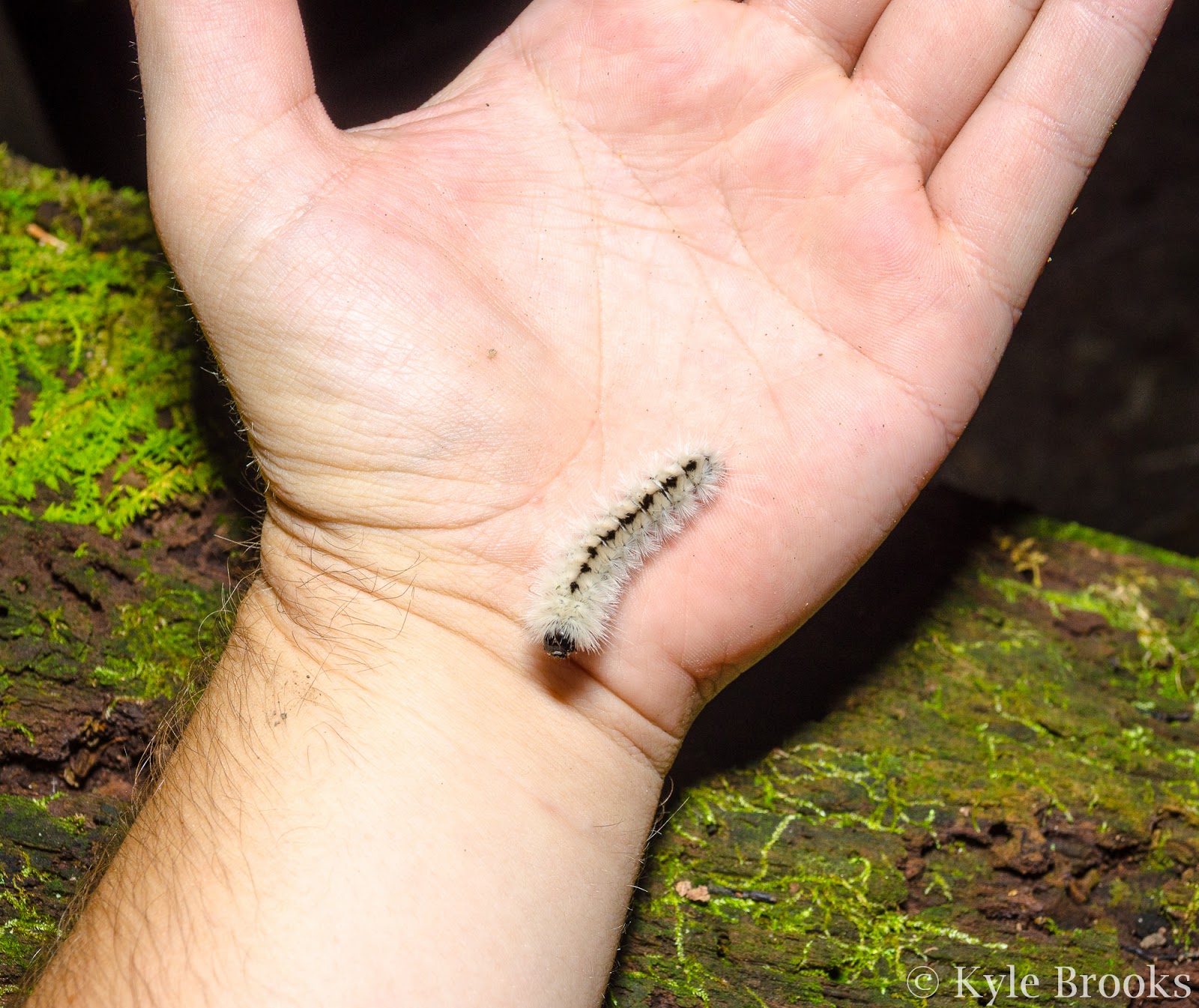The Hickory Tussock Moth, Lophocampa caryae, is a species belonging to the Tiger Moths (Tribe Arctiini). The rather dashing adults look like this. The caterpillars, on the other hand, are black and white. These caterpillars are covered in white hairs with a central line of black hairs running down their back.
 |
| Reports of the Hickory Tussock Moth courtesy of Butterflies and Moths of North America. |
But the main thing I want to talk about is their supposed venom/poison, which many stories will say is very dangerous to humans. First, let's clarify what poisonous and venomous means. Poison means a toxin that is ingested (i.e. if you eat it and get sick, it's poisonous). Venom is a toxin that is injected into you via fangs, a stinger, or some other modified part of the body (i.e. if it bites or stings you and you get sick, it's venomous). Unless you plan on eating a caterpillar, the only way it could be dangerous to you is through venom. But is the Hickory Tussock Moth caterpillar venomous?
The short answer is
no, the Hickory Tussock Moth caterpillar is not venomous; however, it is a
bit more complicated than that. So, let’s start with the basics. Many
caterpillar species are covered in hairs called setae. These setae help with
sensation, like how a cat’s whiskers do. Many times these setae are harmless (like in the Woolly Bear), but in some species these hairs can break off into an animal’s
skin and cause irritation, sort of like a cactus’s spines or bristles. In some
other species, like the caterpillars of the Flannel Moths,
these setae have been modified into hollow spines, and at the bottom of the
spines are venom glands, sort of like a bee’s stinger. The caterpillars with these
spines and venom glands can truly be called a venomous caterpillar, but does
the Hickory Tussock Moth caterpillar have these? The answer is no. Hickory Tussock Moth caterpillars do not have
stinging spines nor venom glands (Hartmann 2009, Kuspis et al. 2001). They do,
however, have the irritating setae that I previously mentioned. But, are
they really that irritating?
Citations:
Hartmann, T., 2009. Tiger moths and woolly bears. Behavior, ecology and evolution of the Arctiidae.
Kuspis, D.A., Rawlins, J.E. and Krenzelok, E.P., 2001. Human exposures to stinging caterpillar: Lophocampa caryae exposures. The American journal of emergency medicine, 19(5), pp.396-398. Link.
People will often comment on these stories with horror
stories about how either they or someone they know touched one of the caterpillars and had
a horrible reaction, with some even saying they had to go to the ER. This is not the norm, at all. Some
people are, for whatever biological
reason, hypo-sensitive to the setae of this species. They can experience pain
and bad rashes, yet the average person will not experience this. Let me give
you an analogy. Some people are allergic to peanut butter, but the vast majority
of people aren’t. Would you say peanut butter is poisonous/dangerous to the
average human? No, you wouldn’t. It is the same with the Hickory Tussock Moth
caterpillar. A very small percentage of people will have a bad reaction to the setae of this
species, but the average person will either have no reaction, or they might
itch a bit. To prove a point for science, I pet this Hickory Tussock Moth
caterpillar. And not just once — I pet him several times. And what happened? Pretty much nothing. I had a few itchy
sensations, but nothing hurt and there was no rash or anything. So much for being a scary and dangerous caterpillar!
Is the Hickory Tussock Moth a species to fear? Not at all! These little guys are just another victim of social media getting animal facts incorrect. It's especially sad to see news organizations (like CBS which claimed this caterpillar wasn't native to the US and that is has venom glands) perpetuating these incorrect "facts." Thanks for reading!




Great post, and very timely. Sharing on my Facebook wall.
ReplyDeleteThank you Lisa!
DeleteI tested the Hickory Tussock setae on myself 2 years ago. I rubbed the sensitive skin on the inside of my wrist on a full-grown Hickory Tussock caterpillar firmly enough that I could feel it prickle. In a minute or two I felt a slight stinging sensation similar to stinging nettle, but much weaker. Then it itched a bit. Total time about 15 minutes. But 3 weeks ago I met a woman who said that she had just nudged one gently onto a leaf with her finger, and the finger swelled up a lot. She sounded very credible and wasn't complaining about it. So I expect it's just a matter of your allergy level. I would advise people to discourage their children from touching them. (I'm not allergic to poison ivy or most mosquito bites, so I expect my allergy sensitivity is low.)
ReplyDeleteThank you!
ReplyDeleteFunny that if you look up the Hickory tussock caterpillar/moth it's states completely different then this non sense who can we believe ? A blogger or the internet with accredited sources ?
ReplyDeleteTo be honest what do we believe
DeleteDo I would say leave it alone
That way you run into problems. So Leave it alone
How can you believe the non sense written here when the author thinks Ottawa is a province in Canada lmao
ReplyDeletedoublechecked with wikipedia. What’s written here is true. Thank you very much for taking the time and effort to write this very informative article!!! 🙏😊👍
ReplyDeleteTo the anonymous troll of 2024: I recommend you find a way to verify what you read when you do a search! 90% of stuff that comes up on a google search is fake. For me, wikipedia is one of the very few resources that are trustworthy…